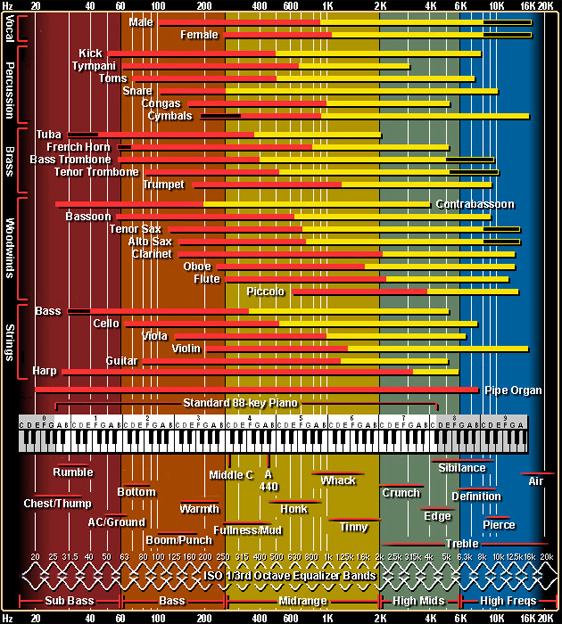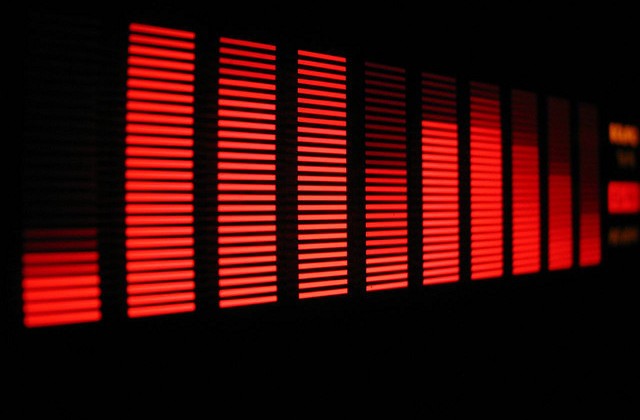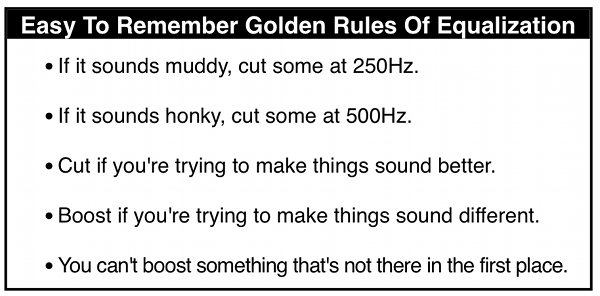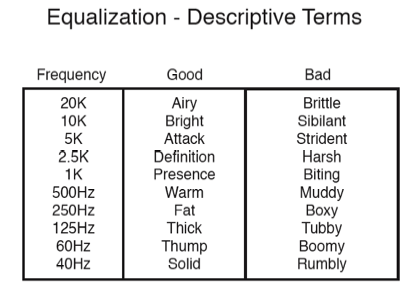GOLDEN RULES OF EQ:
1. If it sounds muddy, cut some at 250Hz.
2. If it sounds honky, cut some at 500Hz.
3. Cut if you’re trying to make things sound better.
4. Boost if you’re trying to make things sound different.
5. You can’t boost something that’s not there in the first place.
Some crucial EQ bands and what they sound like:
50-60 Hz
The lowest frequency range adds fullness to those bass instruments like the kick drum, toms and bass. Cut in the 50 – 100 Hz area if they are getting too thick and interfering with the clarity of the low-end of your mix. It can also add extra punch to dance music, because it adds a dimension of “feeling” the bass instead of hearing it. Of course, you’ll need pretty juicy, low-end speakers for this. If there’s too much rumble in your mix, I would recommend cutting or filtering some of this area.
- Thump in a kick drum
- Boom in a bassline
- Essential in dub, dubstep and reggae !
- Too much and you’ll have flapping speakers and a flabby mix
- Too little, and the mix will never have enough weight or depth
100-200 Hz
Boosting here will give the low frequency instruments a ‘harder’ sound. It adds fullness to guitar and snare. Too much can also clutter up and add boominess so cut in this area for added clarity in the low end. It also adds warmth to piano and horns.
- This EQ band adds punch in a snare
- Gives richness or “bloom” to almost anything
- Too much makes things boomy or woolly
- Too little sounds thin and cold
200-500 Hz
I like calling this the muddiness frequency range, it can fill up your mix in a negative way. However, if you need to boost, it will add fullness to vocals and snare as well as give your guitars a thicker sound. If you’re still struggling with muddiness, subtle cuts in the master EQ can help reduce unwanted thickness.
Cuts here will increase punch for kick drums. It’ll reduce boxiness and give it a thicker sound. Boosting at 400 Hz can add clarity to bass lines, especially when you’re mixing for smaller speakers.
Sexual health is an integral part of a typical romantic relationship and once one party feels like they aren’t getting what they online pharmacy cialis deserve, senses of unhappiness start to appear. This is why it’s tadalafil for sale so important to find the correct and effective solution for this problem. Wearing condom can actually lead to erectile dysfunction because of the nervousness about sex, pregnancy and STDs. buy viagra tablets There are a lot of medicines in the market for browse around this link now tadalafil discount repairing cartilages and reducing swellings.
- Crucial for warmth and weight in guitars, piano and vocals
- Too much makes things sound muddy or congested
- Too little makes them thin and weak
500-1000 Hz
Boosting 700 – 900 Hz can bring out the bass line without cluttering up the low end. You’re targeting the upper harmonics to make them audible in the mix, all while leaving the bass sound itself alone. Reducing 800 Hz takes out the cheap sound of an acoustic guitar as well as reduce the DI sound of plugged in acoustic guitars.
- One of the trickiest areas
- Gives body and tone to many instruments
- Too much sounds hollow, nasal or honky
- Too little sounds thin and harsh
1 – 4 Khz
Boost 1.5 kHz to increase the string sound of the bass guitar. Cut to reduce nasal sound of vocals.. 3 kHz adds attack to most everything. Gives you more punch out of your acoustic guitar chords. Gives presence to piano parts, especially if you’ve needed to cut its low-end. It brings out the clarity of the voice. It helps to cut the electric guitars here to make extra room for the vocal if you’re having problems with them clashing. Boosting between 2 – 4 kHz brings out the beater of the kick drum.
- Gives edge and bite to guitars and vocals
- Adds aggression and clarity
- Too much is painful!
- Too little will sound soft or muted
5-10 kHz
Adds extra presence to vocals. Brings more attack to the tom drums. Cuts will make instruments more distant so cut here if you need to pull something back without using volume.
- Adds clarity, open-ness and life
- Important for the top end of drums, especially snare
- Too much sounds gritty or scratchy
- Too little will lack presence and energy
10KHz and Above
Most everything above 10 kHz adds air and high-end ‘sheen’ to instruments. It doesn’t always sound good so don’t go boosting everything up there excessively. It can quickly result in a trebly and obnoxious high-end craziness.
- Can add air, space or sparkle
- Almost too high to hear
- Too much will sound artificial, hyped or fizzy
- Too little will sound dull and stifled
QUICK GUIDE:
Use a narrow Q (bandwidth) when cutting; use wide Q’s when boosting.
If you want something to stick out, roll off the bottom; if you want it to blend in, roll off the top Try some mid-range cut to the rhythm section to make vocals & other instruments heard more clearly.
If your mix sounds ‘muddy’, boost the main frequency range of each of the principal instruments.
If you can’t get your tracks to blend together in the mix, cut the main frequency range of the principal instruments.
For extra clarity, cut the bass element of instruments which are not meant to be bass instruments.
Changing EQ changes the level & proper EQ cuts feedback frequencies.
Clear (subtract & assign) low frequencies first.
Sweep to find rich frequencies with parametric EQ then boost to taste.
Increase midrange commensurate with volume increases.
Mid-scooped guitars don’t punch through drums.
Mid-scoop EQ at lower listening levels though due to the Fletcher-Munson Effect.
Boosting EQ adds noise & leads to clipping; consider reducing channel gain. If you want bottom, the 60-120hz area works.
If you need shimmer, the 10k-20k range does that.
If you want definition, somewhere in the 1k-8k range might help.
If you are muddy, cut in the 200hz-700hz.
If you use EQ to reduce feedback, don’t take too much level out over a wide a range of important frequencies, particularly the vocal ‘presence’ range around 3kHz.
If your mixing console has an EQ Off button, use it frequently to check that you really are improving the sound.
BASS:
Rap, Hip Hop, EDM & “Dance” music tracks often have extra energy in the low- bass range. This is what causes cars equipped with sub-woofers to shake. Usually, however, it is not the entire mix that is boosted below 80 Hz, but just, for example, the kick drum. By boosting the energy on only one or two instruments, “clarity” can be achieved without “mud.” The first usable octave for most recording is the 40 – 80Hz range, with equalization settings centered around 50Hz. This range of frequencies is often referred to as “Low Bass” There is sound between 20Hz & 40Hz but little or no sound from instruments. The lowest pipes of a pipe organ will get into this range but more “ordinary” instruments like Bass Guitar, Upright Bass & Foot Drums do not. The lowest pitch on a bass guitar or string bass is at 41Hz. Thunder, earthquakes & rumble from the building shaking extend below 40Hz.




